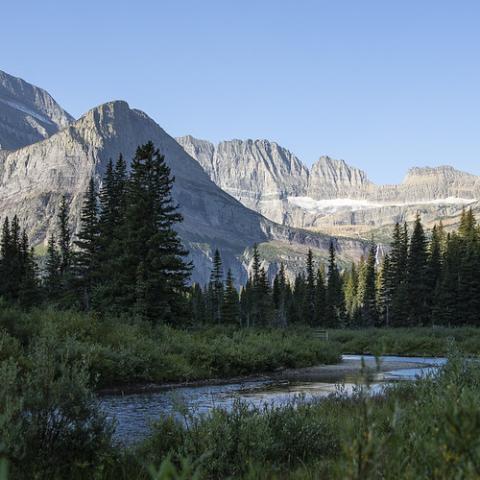Troublesome black bears have been keeping Glacier National Park rangers on their toes, leading to the closure of one campground and requiring the relocation of a sow and her cub.
Because of bears frequenting the area, the Hole in the Wall backcountry campground currently is closed temporarily, along with the small spur trail from the main Boulder Pass Trail to the campground, park staff reported Monday.
The park has re-opened Many Glacier Campground to tent camping after park rangers confirmed that no bear-related incidents have occurred in the area since July 14, when rangers hazed two bears. The campground was first restricted to hard-sided camping on July 6 after incidents involving a black bear that damaged property in the campground. At that time, patrols were increased and the biologists tried, unsuccessfully, to trap and tag the suspected black bear.
In a separate incident last Wednesday at Rising Sun Campground, park resource management staff captured and relocated a different black bear as well as her cub after both bears showed little fear of humans.
The sow, tagged as No. 324, had been frequenting Rising Sun Campground and displaying a pattern of habituated behavior. Her cub of the year also showed signs of being habituated to humans.
Last week, bear 324 apparently killed an animal in the brush near the campground. The loud sounds and lack of visibility in the brush led to the temporary closure of the upper loop of the campground. The remains of a marmot were located the next day.
The following day, park resource management staff encountered bear 324 and her cub in the closed upper loop of the campground. The sow and cub travelled into the occupied loop, despite efforts to keep her out. She passed through occupied tent sites, paying little attention to the presence of park staff or crowds of onlookers. The cub also stood up and pushed on a tent.
Park resource management staff decided that capturing bear 324 and her cub was an appropriate management action according to the park’s Bear Management Guidelines. The sow was tranquilized and placed in a 2-compartment trap. After a short time, the cub entered the back compartment of the trap and was captured.
Last Thursday, park staff released bear 324 and her cub in the North Fork District, far from any campgrounds or developed areas. The hope is that living in a less developed setting will allow her to teach future cubs to live in wild areas, feeding and foraging naturally.
Bear 324 was first captured and tagged in 2015 because she was frequenting Rising Sun Campground. Since then, she has raised several cubs in the area, some of which have required relocation. Sows typically pass on habituated behavior to cubs, requiring more management action for successive generations. In 2017, the park fitted bear 324 with a radio collar to allow resource managers and rangers to target her for hazing, which was somewhat effective.
Resource managers decided that bear 324 was a candidate for relocation rather than removal because she did not exhibit a significant pattern of seeking human food, and did not show signs of aggression.
“These events demonstrate the critical role that campers play in wildlife conservation,” said Glacier Superintendent Jeff Mow. “While bears can wander or even live in developed areas, if we are diligent about keeping food rewards away from them, they can sometimes be relocated rather than euthanized.”
Visitors are reminded to keep campgrounds and developed areas clean and free of food and trash. Local residents and businesses located in and around the park are reminded to secure all types of non-natural food sources including garbage, livestock, feed, pet food, bird seed, and hummingbird feeders.
If you see a bear along the road, park officials ask that you do not stop. Stopping and watching roadside bears will likely start a “bear jam” as other motorists follow your lead. “Bear jams” are hazardous to both people and bears, as visibility is reduced and bears may feel threatened by the congestion. Report all bear sightings to the nearest ranger.
Glacier National Park is home to both black and grizzly bears. Hikers are highly encouraged to hike in groups, make noise when hiking, and have bear spray accessible and know how to use it. Visitors are encouraged to check the park’s Trail and Area Closings and Postings webpage before heading into the park, and to learn more about bears and safety while recreating in bear country.




 Support Essential Coverage of Essential Places
Support Essential Coverage of Essential Places







Comments
As we were ascending The Hidden Lake Trail on September 1, 2018, we escsoed an encounter with a bear. Another hiking group at a higher elevation than us blew their whistle to warn us. The bear was west of us at our elevation coming straight towards us. We had to abandon the trail and climb straight up the cliff. Once we reached a high enough elevation, we saw the bear walk right by the trail. When we exited the trail, the visitor center was closed and there was not a park ranger on site.